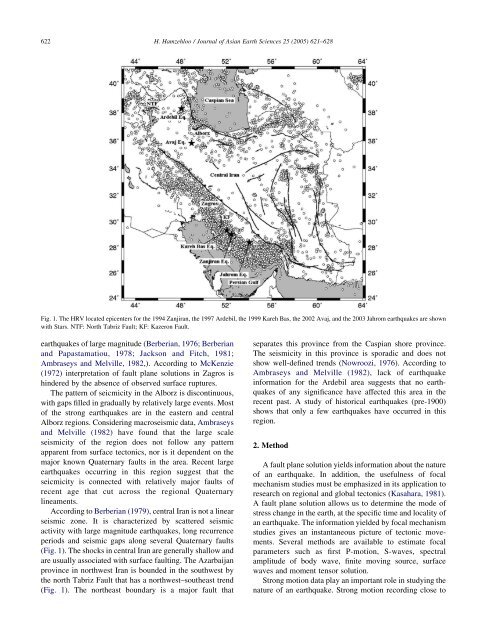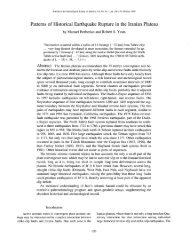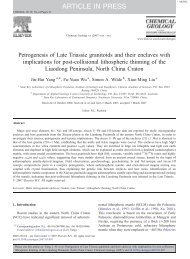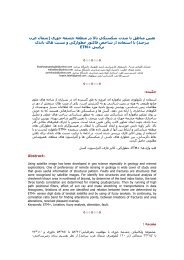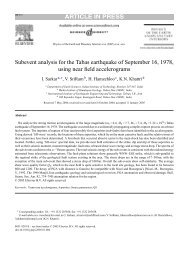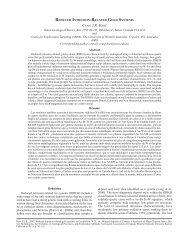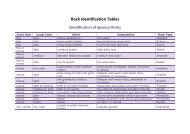Determination of causative fault parameters for some recent Iranian ...
Determination of causative fault parameters for some recent Iranian ...
Determination of causative fault parameters for some recent Iranian ...
Create successful ePaper yourself
Turn your PDF publications into a flip-book with our unique Google optimized e-Paper software.
622<br />
H. Hamzehloo / Journal <strong>of</strong> Asian Earth Sciences 25 (2005) 621–628<br />
Fig. 1. The HRV located epicenters <strong>for</strong> the 1994 Zanjiran, the 1997 Ardebil, the 1999 Kareh Bas, the 2002 Avaj, and the 2003 Jahrom earthquakes are shown<br />
with Stars. NTF: North Tabriz Fault; KF: Kazeron Fault.<br />
earthquakes <strong>of</strong> large magnitude (Berberian, 1976; Berberian<br />
and Papastamatiou, 1978; Jackson and Fitch, 1981;<br />
Ambraseys and Melville, 1982,). According to McKenzie<br />
(1972) interpretation <strong>of</strong> <strong>fault</strong> plane solutions in Zagros is<br />
hindered by the absence <strong>of</strong> observed surface ruptures.<br />
The pattern <strong>of</strong> seicmicity in the Alborz is discontinuous,<br />
with gaps filled in gradually by relatively large events. Most<br />
<strong>of</strong> the strong earthquakes are in the eastern and central<br />
Alborz regions. Considering macroseismic data, Ambraseys<br />
and Melville (1982) have found that the large scale<br />
seismicity <strong>of</strong> the region does not follow any pattern<br />
apparent from surface tectonics, nor is it dependent on the<br />
major known Quaternary <strong>fault</strong>s in the area. Recent large<br />
earthquakes occurring in this region suggest that the<br />
seicmicity is connected with relatively major <strong>fault</strong>s <strong>of</strong><br />
<strong>recent</strong> age that cut across the regional Quaternary<br />
lineaments.<br />
According to Berberian (1979), central Iran is not a linear<br />
seismic zone. It is characterized by scattered seismic<br />
activity with large magnitude earthquakes, long recurrence<br />
periods and seismic gaps along several Quaternary <strong>fault</strong>s<br />
(Fig. 1). The shocks in central Iran are generally shallow and<br />
are usually associated with surface <strong>fault</strong>ing. The Azarbaijan<br />
province in northwest Iran is bounded in the southwest by<br />
the north Tabriz Fault that has a northwest–southeast trend<br />
(Fig. 1). The northeast boundary is a major <strong>fault</strong> that<br />
separates this province from the Caspian shore province.<br />
The seismicity in this province is sporadic and does not<br />
show well-defined trends (Nowroozi, 1976). According to<br />
Ambraseys and Melville (1982), lack <strong>of</strong> earthquake<br />
in<strong>for</strong>mation <strong>for</strong> the Ardebil area suggests that no earthquakes<br />
<strong>of</strong> any significance have affected this area in the<br />
<strong>recent</strong> past. A study <strong>of</strong> historical earthquakes (pre-1900)<br />
shows that only a few earthquakes have occurred in this<br />
region.<br />
2. Method<br />
A <strong>fault</strong> plane solution yields in<strong>for</strong>mation about the nature<br />
<strong>of</strong> an earthquake. In addition, the usefulness <strong>of</strong> focal<br />
mechanism studies must be emphasized in its application to<br />
research on regional and global tectonics (Kasahara, 1981).<br />
A <strong>fault</strong> plane solution allows us to determine the mode <strong>of</strong><br />
stress change in the earth, at the specific time and locality <strong>of</strong><br />
an earthquake. The in<strong>for</strong>mation yielded by focal mechanism<br />
studies gives an instantaneous picture <strong>of</strong> tectonic movements.<br />
Several methods are available to estimate focal<br />
<strong>parameters</strong> such as first P-motion, S-waves, spectral<br />
amplitude <strong>of</strong> body wave, finite moving source, surface<br />
waves and moment tensor solution.<br />
Strong motion data play an important role in studying the<br />
nature <strong>of</strong> an earthquake. Strong motion recording close to


